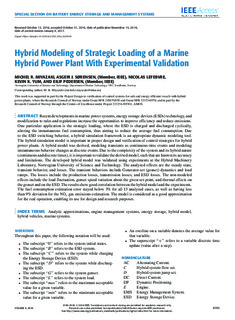| dc.description.abstract | Recent developments in marine power systems, energy storage devices (ESDs) technology, and modification to rules and regulations increase the opportunities to improve efficiency and reduce emissions. One particular application is the strategic loading, where the ESD is charged and discharged cyclically, altering the instantaneous fuel consumption, thus aiming to reduce the average fuel consumption. Due to the ESD switching behavior, a hybrid simulation framework is an appropriate dynamic modeling tool. The hybrid simulation model is important in proper design and verification of control strategies for hybrid power plants. A hybrid model was derived, modeling transients as continuous-time events and modeling instantaneous behavior changes as discrete events. Due to the complexity of the system and its hybrid nature (continuous and discrete times), it is important to validate the derived model, such that are known its accuracy and limitations. The developed hybrid model was validated using experiments at the Hybrid Machinery Laboratory, Norwegian University of Science and Technology. The analyzed effects are the steady state, transient behavior, and losses. The transient behaviors include Generator-set (genset) dynamics and load ramps. The losses include the production losses, transmission losses, and ESD losses. The non-modeled effects include the load fluctuation, genset speed variation about the given set-point, and thermal effects on the genset and on the ESD. The results show good correlation between the hybrid model and the experiments. The fuel consumption estimation error stayed below 3% for all 15 analyzed cases, as well as having less than 9% deviation for the NOx gas emissions estimation. The model is considered as a good approximation for the real operation, enabling its use for design and research purposes. | nb_NO |
